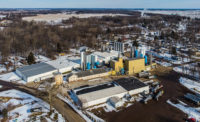When it comes to monikers for dairy cooperatives, Michigan Milk Producers Association (MMPA) is something of a misnomer. The name somewhat belies the fact that the Novi, Mich.-based operation serves nearly 1,600 dairy farmer-owners residing not only in Michigan, but also in Indiana, Ohio and Wisconsin.
But MMPA’s roots do trace back to Michigan. Way back in 1916, approximately 400 Michigan dairy farmers gathered at Michigan Agricultural College in East Lansing, Mich. — what’s now known as Michigan State University — to form MMPA, explained Sheila Burkhardt, senior director of member and government relations for MMPA and a 30-year employee of the cooperative.
“Since that time, MMPA has grown across the state and region and now markets approximately 5 billion pounds of milk annually,” she said.
Diverse range of products
That 5 billion pounds takes the form of a wide range of products, including whole-milk, nonfat-milk and buttermilk powders; butter; fluid milk; cream; condensed skim milk; and cheese, noted Jim Feeney, senior sales director. And MMPA recently added ultrafiltered skim milk to its repertoire with a major expansion to its SQF Level 3-certified Constantine, Mich., processing plant. (See the Inside the Plant feature, page 52).
“We are very excited to have launched our new ultrafiltered milk product line this year,” he said. “Our ultrafiltered milk is being marketed on its merits of high protein, low carbohydrates and low lactose. We have some unique functionality built into the process to serve the innovation driving new product development.”
MMPA operates another SQF Level 3-certified plant in Ovid, Mich. That plant processes 1.4 billion pounds of milk each year.
And in 2017, after acquiring a small cheese plant, MMPA launched the Heritage Ridge Creamery retail cheese brand. The cheese plant for that brand is operated by MMPA’s subsidiary, Middlebury Cheese Company LLC, in Middlebury, Ind.
MMPA’s customer base is very diverse, Feeney noted, comprising local milk bottlers and some of the largest food manufacturers in the world, as well as small and mid-size companies. Most liquid products are supplied to customers in bulk, in the form of tanker shipments. But MMPA is also able to fill gel totes and drums for customers that desire a smaller amount of ultrafiltered milk for research and development purposes.
On the powder side, products are shipped out in bags, he said. Butter goes out in lined cases, while most cheese is provided either in horn form or in barrels. The cooperative produces a lesser amount of cheese and butter for packaged retail sales, too — for retail partnerships, as well as online and in-store purchases.
MMPA has seen a lot of growth in its fluid milk products in recent years, noted Joe Diglio, MMPA’s CEO and a 27-year veteran with the cooperative.
“The growth is really because of the quality and hitting certain specs that our customers are asking for,” he explained.
But the cooperative has seen even more significant growth on the butter side of its business, Diglio said.
“Butterfat now is viewed more favorable by the consumer. So that’s really catapulted our sales and our opportunities in that area,” he said.
MMPA’s butter also has won numerous awards for its taste and quality over the years, Diglio added — a reality that likely has been a result of the commitment to quality on the part of the cooperative’s membership.
Extending beyond commodities
Up until recently, MMPA largely was known only for high-quality commodity-type dairy products. But the cooperative is aiming to change that reality by creating innovative new customer-centric products.
That shift meshes with “progressive,” one of the five critical core values that direct MMPA’s day-to-day operations. (The other four are “leadership,” “integrity,” “quality” and “community.”)
MMPA’s ultrafiltered milk capabilities — with the flexibility to create custom formulations that are higher in protein and lower in lactose — factor significantly into the innovation plan, Diglio said.
“Customers have been actively involved in this investment and the excitement around it,” he noted. “We have the ability to do many different things, and it’s really going to be dependent on what components customers are going to be looking for.”
What’s more, MMPA is now working hand in hand with its customers on the innovation front. Diglio said the cooperative gleans consumer-specific feedback from those customers to jointly create products that will meet the needs of a specific consumer base.
As for the actual product development process, it’s a joint effort involving MMPA’s business development director, sales team, finance team, quality team and manufacturing teams, Feeney explained.
“Our efforts strive to first understand the needs of our customers and the market trends,” he added, “and to include that in any planning of new products to ensure that our growth into new areas is well aligned with the demand and needs of the market.”
MMPA also regularly seeks out feedback from both customers and consumers when it comes to its product development pipeline, stated Josep Barenys, chief financial officer. And although the cooperative’s primary focus is on its longstanding customer partnerships, it also dedicates resources for business development to allow it to explore new opportunities that drive value
for its members.
“Our company culture has been evolving to become a change agent on a crusade against the ‘status quo.’ This evolution has allowed us to deliver significant value for our customers, providing them high-quality product and complementary solutions with a wide range of products and services,” Barenys said.
Investing in growth
Key to innovation — and continued growth — is a commitment to continuous facility investments that go beyond those tied to ultrafiltered milk. As Barenys explained, such investments support member-
producers’ milk growth, customer needs and consumer expectations.
“We have expanded our footprint at Ovid, Constantine and Middlebury, investing in new technologies, which has helped us remain competitive in the marketplace and bring added value for members,” he said.
The expansions also have allowed MMPA to maximize production and gain new customers, Barenys added.
And new technology will continue to spur investments at those plants, Diglio noted.
“The more the technology changes, the more you need to change,” he said.
Investments are a focus outside the plants as well. For example, the milk-testing lab in MMPA’s headquarters just underwent a major expansion. And the cooperative is also working to improve the level of communication to its members, as well as to its customer base, Diglio said.
Additional investments related to new initiatives are on the horizon. Some will involve new assets, while others will comprise expansion efforts within existing footprints, Diglio explained.
“Much of it has to do with our core strategy of progressive, continuing to evolve into something a little bit different than we were yesterday,” he said. “That’s important because one of the keys to success is going to be to continue to diversify our product mix [and] become less reliant on commodities and more reliant on innovation.”
Quality above all
True product innovation might be a new focus for MMPA, but the cooperative has no plans to change some of its other long-held practices. Key among those is guarding the quality of its milk — which Feeney said is known for being among the highest in the industry.
As proof, MMPA’s membership comprises a “significant percentage” of the farms recognized in the National Mastitis Council’s annual National Dairy Quality Award program, Burkhardt noted. (In 2019, MMPA member farms took home more than a quarter of the 41 awards.)
Quality is one of the cooperative’s five core values, and it is an attribute that sets it apart, Diglio believes.
“When your member-owners produce the kind of quality that we receive from them, that certainly gives us an opportunity to do something that others in the marketplace can’t,” he stressed.
To help its member-owners on the milk quality front, MMPA offers a portfolio of member services, Burkhardt said. Approximately 20 member representatives work directly with the cooperative’s members to help them meet their quality goals and exceed customers’ expectations.
“We’ve invested a lot of money into quality with our members through our field staff,” Diglio pointed out. “Giving [our members] a resource that can go on the farm and help them achieve some desired results tied to quality standards is very instrumental to their success as well.”
Like many other dairy cooperatives, MMPA also offers a milk quality premium program whereby the producer’s pay price is impacted, positively or negatively, by somatic cell count.
Entrenched in the communities
Community is just as important to MMPA as its other four core values.
For example, MMPA’s members are involved in community outreach activities that range from hosting farm tours to visiting classroom to talk about the dairy industry, Burkhardt said. Several of MMPA’s members have even opened up their farms to “Breakfast on the Farm” events. These popular events, which showcase modern dairy farming operations, attract a couple thousand people.
In addition, MMPA is very engaged in its communities as an organization.
“As a cooperative, we are proud to have been involved in providing milk donations — nearly 200,000 gallons total — to the Food Bank Council of Michigan for the last four years,” Burkhardt stressed. “Over the last two years, we have worked with Michigan Dairy, operated by Kroger, to donate 150 gallons of milk per day to the food banks in Michigan. MMPA delegates have been supportive of these efforts by passing a resolution applauding MMPA’s involvement in milk donation activities.”
Giving back to the community isn’t limited to milk donations, however. Case in point: During a recent weather emergency bringing double-digit sub-zero temperatures, Michigan’s Consumers Energy utility company had to severely restrict gas usage to be able to adequately service all of the state’s residents. The company reached out to MMPA to ask the cooperative to voluntarily back down its usage at one of its plants.
“In a very quick period of time — we’re talking within hours — we moved our gas usage from being full-throttled and handling all of the milk that was going through to minimal amounts,” Diglio said. “We knew we wanted to do what we could for the residents and the community to help them keep their heat on.”
He added that the plant’s team did a remarkable job, with everyone understanding and adhering to MMPA’s core value of community.
Connected to the industry
MMPA is also actively involved in numerous dairy industry organizations — with those organizations representing both the processor and producer sides. And MMPA executives hold a leadership role in many of them.
For example, Ken Nobis, MMPA’s president, serves on the board of directors for the U.S. Dairy Export Council and is the first vice-chair of the board of directors for the National Milk Producers Federation. Feeney, meanwhile, is an American Dairy Products Institute board of directors member, while Diglio serves on the boards of directors for the Innovation Center for U.S. Dairy, the National Council of Farmer Cooperatives and the National Milk Producers Federation.
Those and other leadership roles in industry organizations mesh with MMPA’s core value of leadership.
“[It’s] being actively involved regulatory-wise, legislative-wise, having the connections and being at the table to help drive policy
that will favor the industry,” Diglio stressed.
Barenys added that collaboration is a “key driver” for the cooperative. And that collaboration extends well beyond industry associations and other formal groups.
“MMPA is an organization that creates strong alliances with other industry players that want to make the dairy industry better and bigger by creating win-win business models from the cow to the shelf,” he explained. “We have been building strategic alliances with customers and other co-ops that share the same principles of creating a sustainable business model, advocating for quality excellence and being progressive in the way we develop the business.”
Preparing for challenges
Like most other dairy processors, MMPA does face some potential obstacles to growth in the years ahead. One challenge is the current trade situation, Diglio pointed out.
“To the extent that we can move our product on a global platform more readily will provide us with huge opportunities,” he said. “We’re continuing to work with our legislators on addressing these issues, getting them to understand the impact they have on processors and farmers alike.”
Milk production growth in the region is also a concern. Although MMPA has identified projects to help, there’s still a need to improve milk economics, Diglio said.
“The price needs to be more than what it is today, for sure,” he noted. “And that certainly becomes a hindrance on our member-owners. But you can’t, as one organization or one company, change the milk pricing on your own; you have to do it through the efforts of the industry.”
Another challenge that’s completely unique to MMPA is quickly building up business for its new ultrafiltered milk capabilities. As Diglio explained, the cooperative is really at the starting point in helping its customers develop added-value products here. He envisions being well beyond the initiation stage of this new investment a year from now, however.
“I see immense opportunities for us to diversify off of whatever products come off of those assets,” he said.
Admirable goals
In addition to ramping up production on the ultrafiltered milk side, MMPA has some other lofty goals for the next year or so. Diglio wants the cooperative to move into more of a regional platform, something it’s been working toward in recent years. It will get there through customer relationships, product quality and enhanced communications.
Continued diversification also is a short-term goal.
“We’ll continue to be looking for innovative solutions in product categories that are looking for growth,” Diglio said. “We’re fortunate because our member-owners have an appetite for investment and the desire to achieve what we’re looking for in the value-added stream.”
Looking further down the road — to the next five years and change — Diglio said he expects MMPA will have navigated more significantly away from some commodity dairy products. To get there, the cooperative will rely on additional research and development in partnerships with customers to create more value-added, consumer-centric products.
“It’s going to be hard work — nobody said it would be easy,” he stressed. “But it’s going to be a means of growing the co-op in a way that makes our member-owners successful. If you can’t do that, you don’t have a viable business.”








